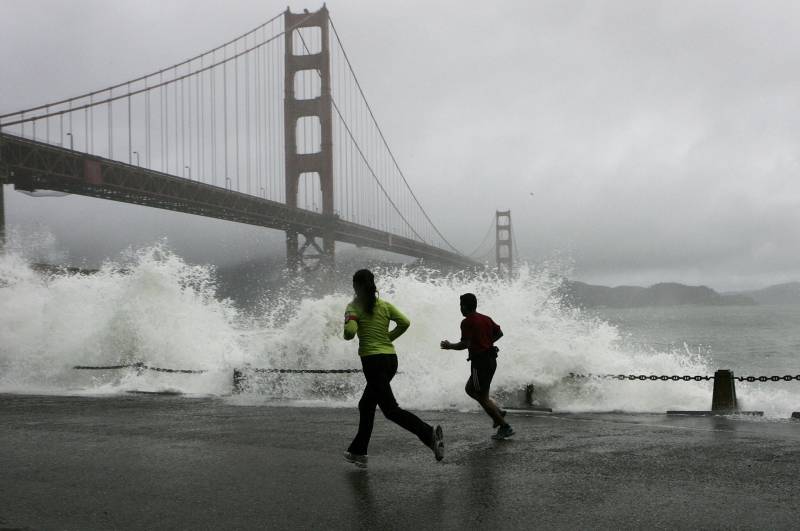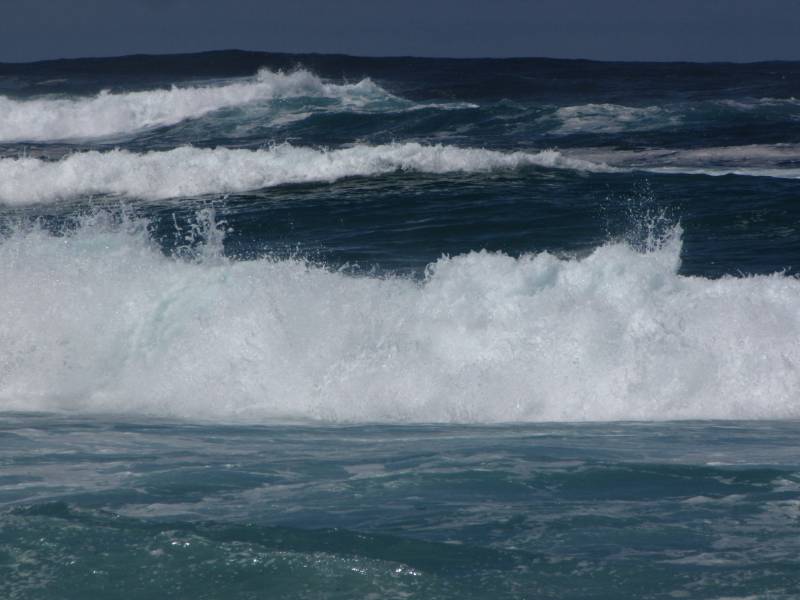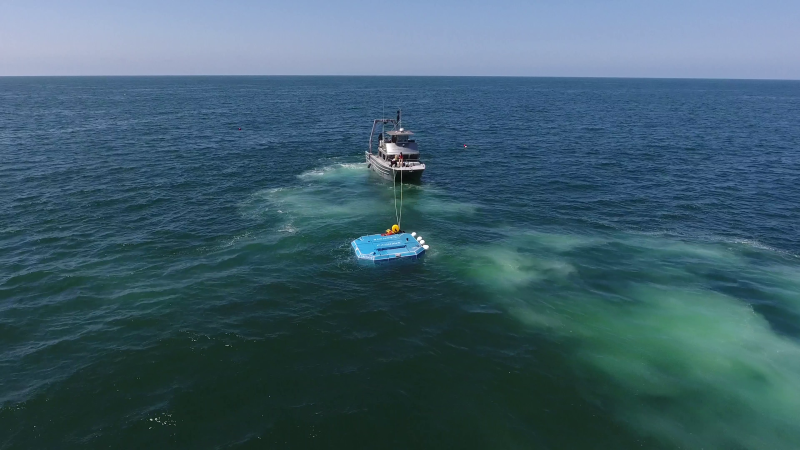Episode Transcript
This is a computer-generated transcript. While our team has reviewed it, there may be errors.
Olivia Allen Price: Hello everybody, I’m Olivia Allen Price. And this is Bay Curious. I want to start today’s episode … at the ocean.
[crash of an ocean wave]
And my gosh, whenever I look at the waves, I can’t help but marvel at their power … the sheer amount of energy they have.
[sound of ocean waves continues]
These waves have been on the mind of a Bay Curious listener…
Alex Kwok: My name is Alex Kwok. I’ve lived in the Bay Area for pretty much my whole life. Grown up in Fremont.
Olivia Allen Price: Alex is a generally curious person. Random questions pop into his mind all the time.
Alex Kwok: Every time I kind of hear about the state going through another rolling power outage, or PG&E cutting power … that usually sparks some sort of thinking on my part.
Olivia Allen Price: When it comes to green energy, he’s seen a lot of solar and wind energy projects here in California. But they have drawbacks. The wind doesn’t always blow. And the sun does set. Every day, actually. But the Ocean …
Alex Kwok: Okay, the ocean is always there. The tides are always going in and out, right? Why is there no talk about tidal power? Are there no companies testing any kind of tidal power technology here?
Olivia Allen Price: Today on Bay Curious … we are going to explore the potential of harnessing the ocean for energy. It’s a largely untapped frontier, for a few sensible reasons actually. But the tide may be turning … I’m Olivia Allen-Price. We’ll explain more after the break.
We sent reporter Holly J. McDede to answer Alex Kwok’s question. Turns out, San Franciscans have tried to tap into ocean energy for more than a century.
[sound of ocean waves]
Holly McDede: The year is 1868, and a mechanic now known as “Mr. Robertson” has devised a grand experiment: a boat powered by not steam, or wind … but ocean waves!
Mr. Robertson and a few passengers set sail from San Francisco’s North Beach. The New York Times documented the adventure …
Voice-over actor: In his mind’s eye the inventor saw the new boat traveling the waters like a being of life, riding the billows sea-serpent fashion …
Holly McDede: But almost from the start, the experiment went sideways. Literally.
Voice-over actor: She was hardly clear of the wharf when she swung around broadside to the tide and commenced bobbing and ducking in a most unpromisingly perverse manner, refusing to obey the helm at all.
Holly McDede: Before the boat even made it out to sea, the passengers had to be rescued. The grand experiment to build a boat powered by waves came to an end.
But our quest to harness the ocean would not stop there …
[music]
Flash-forward 130-some years to the early 2000s. This time, it was San Francisco city leaders who had a grand idea. Following what they’d seen done elsewhere … they thought a device, like a windmill, could be placed under the Golden Gate Bridge … its blades turned by the water to generate power.
Then-Mayor Gavin Newsom boasted about this when he was running for governor in 2009.
Gov. Newsom: Think about the mouth of the Golden Gate, the Bay, it’s relatively small, you’ve got this great energy that comes in and out, 24/7, all of that energy being wasted! Again. You’ve got the opportunity to do what’s been done in other countries, and that’s harness that energy flow.
Holly McDede: The future, he said, was now!
Never mind that just a year before that, a study paid for by the San Francisco Public Utilities Commission said the whole idea was not economically feasible.
First off, it’s expensive. That study found that the turbines would cost as much as $15 million each … and $750,000 a year to maintain.
And it turns out the turbines would be way less productive than promised. Finally, there were environmental concerns. Even Newsom was clued into those.
Gov. Newsom: This one has become more complicated, a lot of environmental concerns, if you have Plankton coming in, seals and sea lions … who knows what else, getting sucked up and consumed …we’re working on all those issues. [Laughter]
Holly McDede: And creating things meant to last underwater is really hard. Just look at how beat up a buoy gets or the rotten pillars of a pier. Salt is tough stuff!
Dan Kammen: Technology wasn’t ready, but the planning really was. Now these hardware options have caught up to that.
Holly McDede: That’s Dan Kammen, a professor of energy at the University of California, Berkeley.
Dan Kammen: It’s a very simple answer to the question why there hasn’t been a lot of this before. It’s really because the focus on clean energy for the past two decades has been first on solar and then on wind, or depending. There’s a little mix and match there. But this is just one that hasn’t gotten as much attention until recently.
Holly McDede: California is aiming to be powered 100% by clean energy by 2045, but there’s still a long way to go. The state was at 37% in 2021, mainly coming from wind and solar. Tapping into ocean energy could help chip away at the difference.
Dan Kammen: It’s not going to be a massive part of our energy. But it might be a really well-tailored technology to places that are already thinking about clean energy and have a port, a dock, a whole variety of kind of in the water hardware already.
Holly McDede: Ocean waves do have some big upsides. They are more predictable and reliable than wind. Water is also denser than air, and moving water packs a lot of energy. Kammen and others advocating for this industry are optimistic because of new innovations that aim to reduce costs
Dan Kammen: There are innovative hardware designs, some are big floating snakes, others look like buoys.
Holly McDede: More funding is coming into the industry too. The U.S. Department of Energy is allocating $25 million to help support a new wave energy testing site. It’s located just a few miles from the deep-water port of Newport, Oregon.
There, companies are racing to turn ocean waves into electricity. And one California company … is in the running!
[Music bridge ]
In 2022, a little over a quarter mile off a pier at the University of San Diego, a 16-foot-wide, blue octagon-shaped device called xWave was submerged underwater … and tethered to the ocean floor.
As the water swirls around it …
[Ocean wave sound effects]
The device moved in a circular motion with it, around …
[Ocean wave sound effects]
And around.
Marcus Lehmann: It’s pretty much similar to a wind turbine just with the difference that the wind turbine always runs in the same direction. In our case, the waves just go in circles.
Holly McDede: Marcus Lehmann is the cofounder of CalWave Power Technologies, the Oakland-based company behind that blue device. He developed the technology based on research done at UC Berkeley.
His company was testing out the xWave prototype for about 10 months.
Marcus Lehmann: It felt a little bit like a newborn where we were up at nights and weekends watching it and making sure everything is working fine.
Holly McDede: He says when it comes to wave energy, people are still tinkering with different designs, just like they did in the early days of wind energy. Twenty years ago, there were all sorts of wind turbine designs researchers were testing out.
Marcus Lehmann: The three-blade horizontal that emerged was really more through trial and error, through industrial experience finding it has the best performance, but then also the lowest cost, ultimately.
Holly McDede: During CalWave’s pilot, they continuously exported power through a cable back to the pier.
Marcus Lehmann: We’re not aware of any project in California or continental U.S. that exported power without interruption for that long.
Holly McDede: Next, CalWave is working on building a version of their pilot to be installed at that wave energy test site in Newport, Oregon. There it will share waters with devices built by other companies.
Once the Oregon test site is fully operational in 2025 or so, it could generate enough power … enough to supply a few thousand homes.
To Lehmann that’s just the beginning. He hopes wave energy can compete with offshore wind. CalWave believes wave energy has the potential to meet up to 30% of the United States’ electricity demand.
After all, wave energy could be the world’s largest untapped energy resource.
[music bridge]
It’s been decades since Newsom made that speech declaring that the future of tidal energy is now. And San Francisco embarked on the mission to harness energy in the Bay … but Dan Kammen, the professor of energy we spoke to earlier, believes that the wave energy future … is actually going to happen pretty soon.
Dan Kammen: I will be surprised if in the next five years we’re not seeing wave and tidal technologies being installed for commercial operation, not for testing, but to generate power either for a community or for a community with the excess being sent to the grid.
[music bridge]
Olivia Allen-Price: Sounds like promising stuff, but slow going. Are there places around the world where wave or tidal energy is up and running?
Holly McDede: There have certainly been a lot of attempts! A few projects have come and gone … but funding has always been an issue. There is a fishing village in Spain’s northern coast that does have a wave power plant up and running. Beyond that, several companies are in the research and testing phase.
Olivia Allen-Price: You mentioned the $25 million in federal funding being spent on ocean energy technologies — but is California doing anything to move this along?
Holly McDede: Yes … slowly but surely. A state bill to study the feasibility of wave and tidal energy developments in California is currently moving through the state Legislature.
Olivia Allen-Price: Could we ever see a wave energy site off our coast in the Bay Area?
Holly McDede: It’s possible, but I don’t think the Bay Area is top on the list.
A hot button issue in the green energy space has been ensuring the transition away from fossil fuels doesn’t leave certain people or communities behind.
The federal government is providing incentives for green energy projects that benefit people that have been overburdened by pollution and historic underinvestment. There are coastal communities that are struggling that could stand to benefit from those resources and the promise of wave energy.
Olivia Allen-Price: Alright well, Holly J. McDede, thank you.
Holly McDede: You’re welcome.
[music]
Olivia Allen-Price: If you are new to Bay Curious … Welcome! And be sure to subscribe or follow us wherever you listen to podcasts so you don’t miss a future episode. Be sure to stick around until the end of the show to play our Sierra Nevada podcast trivia game.
Bay Curious is made by Amanda Font, Christopher Beale, and me, Olivia Allen-Price. Additional support from Jen Chien, Katie Sprenger, Cesar Saldana and Holly Kernan.
I’m Olivia Allen-Price, have a great week!


